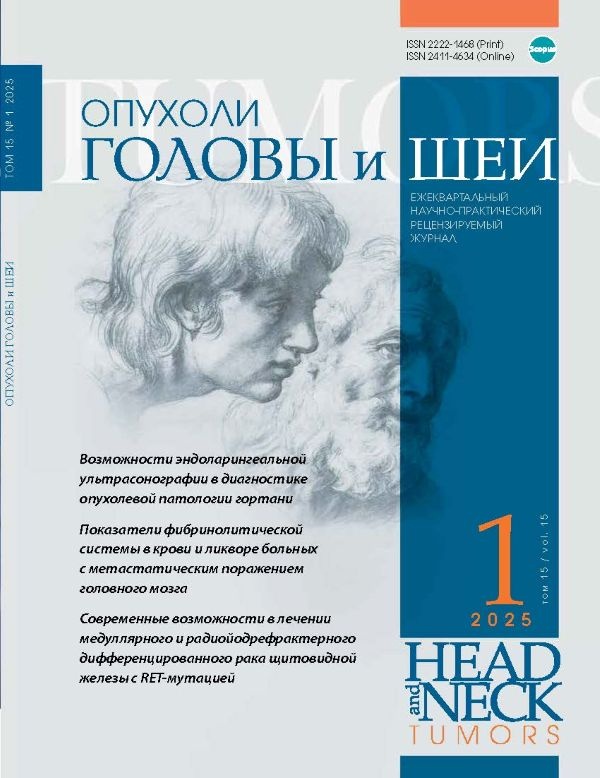Application of free perforator-based medial gastrocnemius flap in oncology patients for oral cavity defect reconstruction
- Authors: Novoselov B.A.1, Sviridenko A.D.2, Mikhailov V.V.3, Kolchanov G.M.4
-
Affiliations:
- Mariinsky Hospital
- Sechenov University, Ministry of Health of Russia
- North-Western State Medical University named after I.I. Mechnikov, Ministry of Health of Russia
- City Clinical Oncological Dispensary
- Issue: Vol 15, No 1 (2025)
- Pages: 26-32
- Section: DIAGNOSIS AND TREATMENT OF HEAD AND NECK TUMORS
- Published: 28.03.2025
- URL: https://ogsh.abvpress.ru/jour/article/view/1039
- DOI: https://doi.org/10.17650/2222-1468-2025-15-1-26-32
- ID: 1039
Cite item
Full Text
Abstract
Introduction. At the current stage of reconstructive surgery development, correction of defects of the oral cavity and tongue in oncological patients is an important component of proper surgical treatment. Therefore, the selection of the most appropriate plastic material including a free revascularized autotransplant (flap) remains an important problem. Usually, radial flap is used due to ease of dissection, thinness, plasticity, long vascular pedicle. However, its use has a serious disadvantage: significant damage of the donor area. The use of antriolateral femoral free flap allows to obtain large volume of soft tissues with minimal injury of the donor area. However, it can be too large due to the thickness of subcutaneous fat and cannot be used to correct small and medium sized defects of the oral cavity. Therefore, the use of medial sural artery perforator flap is an excellent alternative due to its thinness, plasticity and minimal damage to the donor area.
Aim. To evaluate the effectiveness of using medial sural artery perforator free flap for reconstruction of defects of the oral cavity in oncological patients.
Materials and methods. The retrospective study included 8 patients with tumors of the oral cavity and tongue (3 men, 5 women) who underwent surgical treatment at the Mariinsky Hospital (Saint Petersburg) between May of 2020 and January of 2022. Mean patient age was 53 years. For single-step defect reconstruction, medial sural artery perforator free flap was used. Mapping of artery perforators of the future flap was performed using Doppler ultrasound.
Results. The flap was successfully used in 7 of 8 cases. Venous ischemia of the flap on day 1 after surgery developed in 2 patients in whom 1 venous anastomosis was used which led to the necessity of vascular anastomosis revision. Flap loss occurred in 1 case due to late diagnosis of ischemia. In 1 case, due to anastomosis revision, flap perfusion was restored. Donor area was sutured without skin grafts which led to satisfactory esthetic results. In 1 case, partial wound dehiscence occurred and the donor area healed under secondary tension.
Conclusion. The use of medial sural artery perforator free flap is an effective technique for reconstruction of defects of the oral cavity in oncological patients with minimal damage of the donor area and good functional results. However, in our opinion, the use of this flap requires two venous anastomoses, accurate and delicate intramuscular perforator dissection due to their small diameter.
About the authors
B. A. Novoselov
Mariinsky Hospital
Email: fake@neicon.ru
ORCID iD: 0009-0003-8193-4859
56 Liteyny Prospekt, Saint Petersburg 191014
Russian FederationA. D. Sviridenko
Sechenov University, Ministry of Health of Russia
Author for correspondence.
Email: dr.artemsviridenko@gmail.com
ORCID iD: 0000-0002-5547-1892
Artem Dmitrievich Sviridenko
Bld. 2, 8 Trubetskaya St., Moscow 119991
Russian FederationV. V. Mikhailov
North-Western State Medical University named after I.I. Mechnikov, Ministry of Health of Russia
Email: fake@neicon.ru
ORCID iD: 0009-0008-9890-1400
41 Kirochnaya St., Saint Petersburg 191015
Russian FederationG. M. Kolchanov
City Clinical Oncological Dispensary
Email: fake@neicon.ru
ORCID iD: 0000-0001-7202-7630
56 Veteranov Prospekt, Saint Petersburg 192288
Russian FederationReferences
Supplementary files







